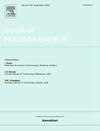利用高斯过程回归重建堆芯内探测器测量的功率分布
IF 2.3
3区 工程技术
Q1 NUCLEAR SCIENCE & TECHNOLOGY
引用次数: 0
摘要
为了安全高效地运行压水堆,监测整个运行周期的中子通量和功率分布是必要的。目前运行的大多数反应堆都有芯内仪表系统,能够进行装配方向的轴向集成通量测量。然而,商业反应堆通常只有少数燃料组件包含用于堆芯内仪表的导管,因此有必要估算剩余燃料组件的功率值。这项工作采用高斯过程回归,一种非参数监督学习方法,仅使用测量数据来预测整个核心的功率分布。OpenMC蒙特卡罗代码用于模拟来自仪器化装配体的探测器信号,并在非仪器化装配体上生成参考值,从而验证回归方法。在检测器完全可用的情况下,平均和最大相对差异分别低于0.8%和2.5%。考虑到单个探测器的故障,最大相对误差不超过5.3%,表明该模型作为实时重建堆芯功率分布的运行监测系统是可行的。本文章由计算机程序翻译,如有差异,请以英文原文为准。
Power distribution reconstruction from in-core detector measurements using gaussian process regression
In order to safely and efficiently operate pressurized water reactors, it is essential to monitor neutron flux and power distributions throughout the operation cycle. Most of currently operated reactors have in-core instrumentation systems capable of taking assembly-wise axially integrated flux measurements. However, commercial reactors typically possess few fuel assemblies that contain guide tubes for in-core instrumentation and it is necessary to estimate power values at the remaining fuel assemblies. This work employs gaussian process regression, a non-parametric supervised learning method, to predict the power distribution over the entire core using only measured data. The OpenMC Monte Carlo code was employed to emulate detector signals from instrumented assemblies as well as to produce reference values at non-instrumented assemblies against which the regression method was validated. The mean and maximum relative discrepancies were below 0.8% and 2.5%, respectively, in a scenario with full detector availability. Considering the failure of a single detector, the maximum relative discrepancy did not exceed 5.3%, showing the feasibility of the model as an operation monitoring system capable of real-time reconstruction of the core power distribution.
求助全文
通过发布文献求助,成功后即可免费获取论文全文。
去求助
来源期刊

Annals of Nuclear Energy
工程技术-核科学技术
CiteScore
4.30
自引率
21.10%
发文量
632
审稿时长
7.3 months
期刊介绍:
Annals of Nuclear Energy provides an international medium for the communication of original research, ideas and developments in all areas of the field of nuclear energy science and technology. Its scope embraces nuclear fuel reserves, fuel cycles and cost, materials, processing, system and component technology (fission only), design and optimization, direct conversion of nuclear energy sources, environmental control, reactor physics, heat transfer and fluid dynamics, structural analysis, fuel management, future developments, nuclear fuel and safety, nuclear aerosol, neutron physics, computer technology (both software and hardware), risk assessment, radioactive waste disposal and reactor thermal hydraulics. Papers submitted to Annals need to demonstrate a clear link to nuclear power generation/nuclear engineering. Papers which deal with pure nuclear physics, pure health physics, imaging, or attenuation and shielding properties of concretes and various geological materials are not within the scope of the journal. Also, papers that deal with policy or economics are not within the scope of the journal.
 求助内容:
求助内容: 应助结果提醒方式:
应助结果提醒方式:


